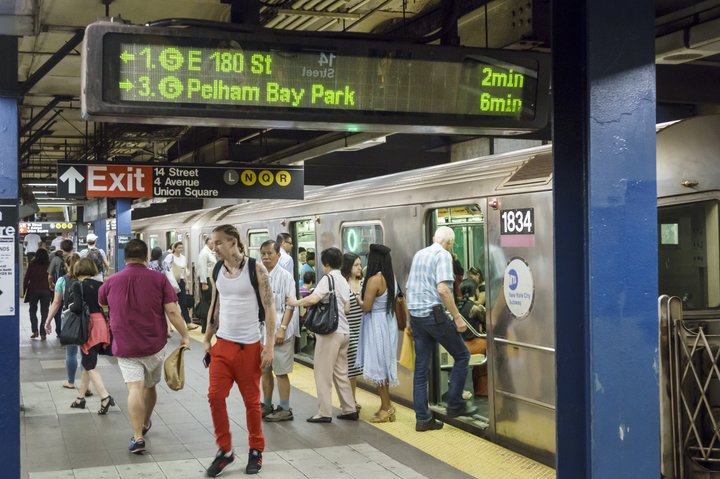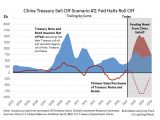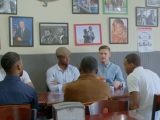
Which Commute Will Save You During the L Train Shutdown?
June 22, 2018In early 2019, the L train in New York City will shut down for 15 months to repair damage caused during Hurricane Sandy. Leading up to the closure, VICE will be providing relevant updates and policy proposals, as well as profiles of community members and businesses along the affected route in a series we're calling Tunnel Vision. Read more about the project here .
A triage of shuttle buses and extended routes. Ferry service both permanent and temporary. Connections to other existing subway lines. Bikes. Scooters. Private cars. Car-shares. Ride-shares. And, of course, the original mode of transport: feet.
These are the alternatives available to the 275,000 commuters who will have to reroute their daily lives come April 2019, when the L train officially goes offline between Brooklyn and Manhattan for over a year. It is a shifting urban Rubik’s Cube, one that will compose what many are calling the biggest transit challenge New York City has ever seen. Attached are the hopes and dreams that everything will, somehow, work out. But until that day comes, nobody really knows for sure what havoc the L train shutdown will wrought—or which commute will reign supreme.
That lack of clarity was the major driving force behind “Everything But the L Train: The Williamsburg Challenge,” a recent weekend event held by the Van Alen Institute. The non-profit design organization dispatched teams of participants to essentially do trial runs of the L-pocalyspe; their mission: get from Union Square in Manhattan to North Williamsburg without using the L. (Of course, some of the alternatives—the temporary ferry service, new buses, and more frequent subway service—do not exist yet.) And during the trip, participants were outfitted with data-tracking biosensors to monitor their health and mood.
In the past, the Institute has hosted an “L Train Shutdown Charrette,” an all-day design competition for new shutdown ideas, and commissioned a Health Impact Assessment of the shutdown (which VICE covered here). They are also planning a flash design competition for Essex, Grand, and Delancey Streets, which will be a heavily used corridor during the shutdown.
VICE spoke with Andrew Brown, the associate director of research at Van Alen Institute.
VICE: So first and foremost: what was the challenge's purpose?
Andrew Brown: The challenge came about because we were looking for content to do for our spring programming festival. We usually do a week's worth of programs, twice a year. They're always kind of community-oriented, and just trying to get out on the streets and have people do something that's a little bit interesting... We're always looking for a way to revisit this question [of the L train shutdown], and our new programming coordinator was the one who came up with the idea for the challenge: let's take a Sunday, and let's get people to take all the different routes to get from Union Square to Williamsburg without taking the L. And then when they get over to Williamsburg, we'll sit them down, and have them talk to folks from The Institute for Transportation and Development Policy (ITDP) about what that experience was like.
And what were those experiences like? What was the feedback?
One of the analysts broke down a framework for talking about the experience. One was obviously mode: some people walked to the J; some people took a bus to the J; some people biked from Union Square over to Berry and North 8th. The other was time: how long did it take you to get there? The people who biked got over in 20 to 25 minutes, which was ridiculously shorter than the people who took the bus to the train, which was 70 minutes, and the people who walked to the J, which was 80 minutes. It was almost embarrassing.
One other criteria was mood: How did you feel? That’s always kind of complicated [to measure], because it's sort of internally biased. For example, one of the two people who biked actually works at ITDP, and self-identifies as a cyclist. So of course, he had a lovely time—racing his bike across the bridge, and stopping to take in the view—compared to the people who took the subway, and kind of had a miserable time.
What did the participants who took the bus and train specifically say? Because those are both going to be major parts of the shutdown mitigation plan.
They got to the Delancey Street-Essex Street station and discovered it had ongoing maintenance work. They didn't know that at the time. So that added a whole other travail to their experience. Then they said, 'Well, at least we didn't have to do this by ourselves.' It's a Sunday event for a nonprofit, and everyone went out as a team. But if this is under normal circumstances, like any given Tuesday [during the shutdown], they might be trying to figure this out by themselves, which would make this totally miserable.
[With buses], it’s a tough one, because you can't really know how tough it's going to be to navigate service roads until after they dump all of those buses on it. But just the time that it took during the challenge, it was the second longest route, and only by ten minutes. Once they got off, they still had to walk from the J up. My impression from what the participants said was that it was kind of a wash between the inconvenience of the train, and the inconvenience of the bus.
I think it's interesting to look at the MTA's plan; there's a plan to add more buses, but there isn't necessarily a plan to make the bus better. So that's interesting to think about, too. With the J train, I want to go to see where the entrances are that the MTA is talking about opening up, because I don't know if that's enough to handle the volume of people that are coming through, and also, just the position of where those entrances are, in comparison to various rights of ways, and what kind of vehicle traffic that people will have to navigate. It just seems like it's going to be a nightmare.
How did you go about studying mood?
The quantitative side was us putting the headsets on people. The recipients were maybe less than ten—so right away, not an experiment-size sample. But it was more the experience of pairing with the devices, making sure the devices are connected throughout the trip, and collecting and analyzing that data. For us, the most important part was visualizing it at the end, so people get a chance to see and understand how they're being affected by the environment, just in terms of their route.
What were the major takeaways from this challenge? What does it say about the shutdown?
It was an interesting conversation, but it was doubly interesting to reflect and say, 'Will everyone want to race their bike across the bridge to get to where they're going?' Probably not. ‘Would they have a smile on their face when they're done?’ Probably not. And, ‘How many people just got through it because they had a friend with them?’ If they didn't, it would've been a totally different experience. Those are the sorts of things that are hanging questions on the qualitative side, after that conversation.
At the end, people talked about what their recommendations would be for the city, from getting employers to embrace more flexible work hours, to trying to add more greenery along these alternate routes—create more green space, and enhance the experience of people taking these paths that are alternatives to the L train... The thought is, if I have to endure this trek, what could make it better?
So what would you say is the best commute during the shutdown?
In terms of travel time, it's almost like, if you can find yourself on a mode where you're the master of your own destiny, then you're in the best situation. Bikes definitely give you that power. You're not waiting on anyone, or anything—you just get on it, and go. But that's obviously a big implication for equity, because not everybody is physically capable or has that desire to pedal hard from Union Square to North Williamsburg, right?
Then with the bus, it's unreliable now, and the strategy during the shutdown is to increase bus service, and ensure that it runs smoothly. It's hard to know what that is going to mean for people's travel times overall. Once we saw that it took 70 minutes to take a bus down to the J, and then get over, nobody was surprised, or had that much confidence that that was going to get much better. It's curious to think about to what extent that will be a deterrent to people, having to switch from the bus to the train. That might keep some people off the buses, and relieve some of the strain.
But ultimately, there's going to be so many people looking for alternate routes, that that's a crazy thing to hope for. There will be more buses, there will be more people taking them, that it will be difficult to keep them running efficiently. And then for the subway, it was the longest, but it is worth noting that it was under renovation. So there was a bit of wayfinding issue; that was one of the things that you heard all the participants mentioning: if there's a service change, there has to be a better way of communicating that than the announcements we get now.
Yeah, in my mind, those X factors during the shutdown actually could make these commute times worse—more people and buses could just mean more crowding and congestion than there are now. And with the subway system in disrepair, it's almost guaranteed that incredibly vital lines, like the J, will be undergoing similar renovations that your participants saw for years to come.
The bottom line for people to remember is that this is a very old system trying to move a ton of people. So there's never a future where we don't have to do a significant amount of maintenance. To me, I'm not a bike pusher, but it is an incentive to get everyone who can bike, and is willing to do so, on that mode of transportation. Because again, it's the one where you have the most power over where you take off, and when you get to where you want to go. That's just the reality.
With the other modes, you are beholden to when it shows up, but also, just for those reasons mentioned, the MTA articulates all the time that work is always going on. And if you're not waiting for something like a bus to arrive, then you're burning time trying to navigate a system that has a ton of scaffolding up, and caution tape, and it's not really clear which platform you should be on, and how you get to it. It's a very difficult system to navigate, and the difficulties are just going to mount overtime. Because we're always going to have to fix these things in a resource-constrained environment. That's not going to change anytime soon.
Sign up for our newsletter to get the best of VICE delivered to your inbox daily.
Follow John Surico on Twitter.


